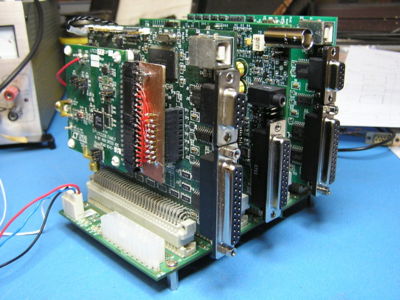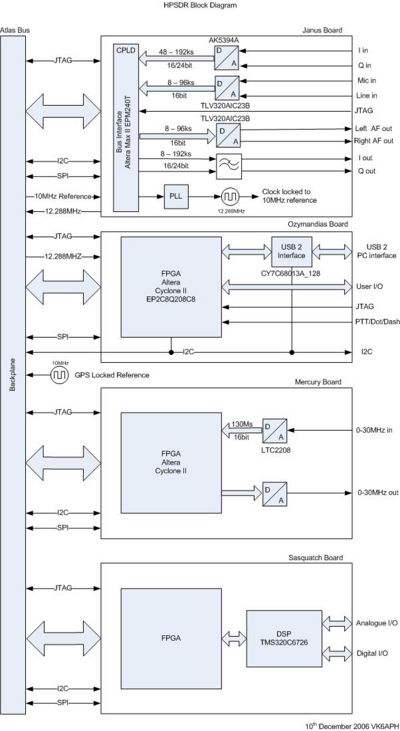Mercury - intermodulation (IMD) tests
The HPSDR is an open source (GNU type) hardware and software project intended as a "next generation" Software Defined Radio (SDR) for use by Radio Amateurs ("hams") and Short Wave Listeners (SWLs). It is being designed and developed by a group of SDR enthusiasts with representation from interested experimenters worldwide. The discussion list membership currently stands at over 900 and includes such SDR enthusiasts as Ray Anderson WB6TPU, Steve Bible N7HPR, Rick Hambly W2GPS, Phil Harman VK6APH, Lyle Johnson KK7P, Ulrich Rohde N1UL, and Bill Tracey KD5TFD to name a few.
The rationale behind the project is to break the overall design up into a number of modules. Each module is designed by an individual or group and connects to other modules using a pre-defined and common bus -- rather like plugging boards into a PC motherboard.
This modular approach enables users to incorporate just the modules that interest them as well as designing their own variants if desired. The approach also enables new ideas and circuits to be tested by replacing an existing module. Since the majority of modules will be retained, such experimentation can be done with minimum disruption to an existing working system.
The modules vary in complexity from simple bandpass filters and input/output interfaces, to full blown DSP functions. Such variety enables experimenters with varying degrees of experience to contribute. If you wish to contribute your skills to this project, the best way is to advise your availability on the discussion list and communicate with project leaders -- or if you have a proposal for a new module, fly it on the discussion list and if feasible, become a project leader!
The modules have each been named for easier identification when talking or writing about them. On this wiki, each module has its own page, as noted by the links below. Some of the modules are being designed so that they can be either used in conjunction with others or stand-alone. Each module board size (except the backplane) will be 100 mm by 120 to 220 mm and use either a 64 pin or 96 pin DIN41612 type connector.
Contents
[hide]HPSDR History and Philosophy
The High Performance SDR project was started in October, 2005 by Phil Covington (N8VB) as the Open_High_Performance_SDR @ Yahoo group. In November, 2005 another small group, based on the Xylo board product (an FPGA experimenter's board) with SDR applications in mind, evolved and the Xylo-SDR discussion list was formed. On March 1, 2006 the two groups merged to form HPSDR and the two discussion lists were replaced with the present HPSDR list.
Initially a small group of developers, HPSDR has grown to over 800 members, including hardware, software and firmware developers; system architects; analog and digital designers; RF engineers; planners, executers and users; testers, documenters and technicians; bank presidents and sanitation engineers. While the last two are dubious, the point is that HPSDR is a diverse group. Everyone has something to contribute and all are encouraged to participate.
The rationale behind HPSDR is to break the overall design up into a number of modules. Each module is designed by an individual or group and connects to other modules using a pre-defined and common bus -- rather like plugging boards into a PC motherboard.
This modular approach enables prospective users to incorporate just the modules that interest them as well as designing their own variants if desired. The approach also enables new ideas and circuits to be tested by replacing an existing module. Since the majority of modules will be retained, such experimentation can be done with minimum disruption to an existing, working system.
The modules vary in complexity from simple band-pass filters and input/output interfaces to full blown DSP functions. Such variety enables experimenters with varying degrees of experience to contribute. If you are interested in contributing, you are invited to join in new or ongoing design, development and documentation efforts.
The modules have each been named for easier identification when talking or writing about them. On the HPSDR website, each module has its own web page. Some of the modules are being designed so that they can be either used in conjunction with others or standalone. Each module board size (except the Atlas backplane) is typically 100mm by 120mm (optionally up to 220mm) and uses either a 64 pin or 96 pin DIN41612 type connector.
Milestone
Here is a photo of a complete Digital Up Conversion/Digital Down Conversion HPSDR transceiver by Phil Harman, VK6APH. The modules are, from left to right - prototype Mercury DDC based on an LT2208 evaluation board and Ozy board - V2 Penelope DUC - Ozy controller board - all sitting on the Atlas bus. Phil had the first QSO (2-way radio contact for the non-hams amongst us) with this on 7 October 2007 which coincided with his 40th anniversary of getting a Ham license!
Block Diagram
Here is a block diagram showing the Janus, Ozy, Mercury and Sasquatch modules and their functions.
Module/Board Availability
Completely assembled and tested, parts kits, and/or bare boards may be available for each of the HPSDR projects on a limited basis. See the FAQ section or individual wiki pages for what is available at the present time. Generally, the boards, kits, or assemblies will be available for purchase through TAPR [1] and an indication of pre-production interest is gaged by a sign-up process located at website http://www.hamsdr.com where one must register, log in, and use the "Projects" tab to get to any list.
Future Modules
In order to provide a complete SDR transceiver other modules will be required. These include bandpass filters, a narrow band I/Q down converter to supplement the Mercury A/D converter, and low power transmitter functions etc.
There is still much to be done in bringing the HPSDR project to fruition. For those experimentally minded Amateurs, this may turn out to be the golden age of (software defined) radio!
Open source design
Brief definition of Open Source
In a "nutshell", open source is a term that is applied to a philosophy, in that the production and organization of a project or system is created through open and cooperative efforts.
Open source software refers to computer software available with its source code and under an "open source license" to study, change and improve its design and functionality.
There are many "Open source software" licenses, the most prominent being the GNU General Public License (GNU GPL or simply GPL), originally written by Richard Stallman. The GPL grants the recipients of a computer program the following rights, or freedoms:
* The freedom to run the program, for any purpose.
* The freedom to study how the program works, and modify it.
* The freedom to redistribute copies.
* The freedom to improve the program, and release the improvements to the public.
The users are treated like co-developers, are encouraged to submit additions to the software, code fixes, bug reports, documentation etc. Having more co-developers increases the rate at which the software evolves. Furthermore, each end user's machine provides an additional testing environment. This new testing environment offers the ability to find and fix a new bug quickly.
[Note: this definition does not go into the various obligations and legalities and is intended to be brief and non-exhaustive. The original was supplied by Kevin, M0KHZ and modified by the WikiSysOp.]
This GPL philosophy extends to the hardware for this HPSDR cooperative project. However it was felt by many that the software GPL and similar licenses would not adequately cover the hardware portion of this project, so an Open Hardware License (OHL) was devised. Also, another license referred to as the NCL - Non-Commercial License, was implemented to take care of situation where the project developers wish to reserve commercial licensing rights. The complete text of the two versions of the OHL/NCL licenses along with some explanation may be found on the TAPR website at http://www.tapr.org/ohl.html
TAPR Affiliation
In early June (2006) it was announced that agreement had been reached with TAPR http://tapr.org for TAPR to provide assistance and a "storefront" for the "products" of the HPSDR group. TAPR has a long history of supporting various digital amateur radio related ventures. We would encourage our members to become TAPR members, not only to support a worthy organization, but also to receive a member discount (usually around 10%) on their HPSDR and other purchases from them.
Assistance in project development is in the form of partial funding for alpha and beta runs of boards upon application to and approval by TAPR's Board of Directors, and then in guiding the manufacturing process. It is not the intention of TAPR to profit from providing this assistance or the manufacture of projects.
It should be emphasized that TAPR and HPSDR are independent organizations or communities and that any TAPR reproduction of HPSDR developed projects is through licensing agreements.
TAPR will be most likely the only source for HPSDR boards due to short runs and the investment required. This does not preclude individuals having their own PCB boards made in keeping with the open-source philosophy. Commercial reproduction may be restricted depending on the license granted by the board developers. Visit the TAPR website http://tapr.org for current availability.
AMSAT Affiliation
In July (2006) the following announcement was made by Rick Hambly W2GPS, AMSAT President:
AMSAT will immediately initiate support for The High Performance Software Defined Radio (HPSDR) project, an independent team that is dedicated to bringing high performance software defined radio devices within the reach of amateurs in terms of access to the hardware and software and at manageable prices. This is a rare opportunity for AMSAT to easily join a major technological development and have a positive impact on both that development and AMSAT's own primary interests. The High Performance Software Defined Radio (HPSDR) project is a completely open source software (GNU Public License) and open hardware design. It has an extremely capable group of core designers, many of whom are also key AMSAT design team members, supported by a cast of hundreds. AMSAT will support HPSDR with a modest amount of financial, personnel and other resources. Financial resources will be under AMSAT control and will be used to support activities such as joint HPSDR and Eagle design meetings. AMSAT's Engineering team will submit a 2007 budget for the AMSAT Board's approval at the annual meeting in October. The modest resources that are needed in 2006 can be provided by the Eagle team project.
Resources
Please be aware that we have a website with pages devoted to each sub-project plus other information and resources. The website will not necessarily contain the latest information (that's the reason we have this wiki) but is a good starting place for a little less technical overview of the project and its parts. The website is at http://openhpsdr.org -- and the website also contains other information and links to many other references and resources of interest to the topics of Software Defined Radio, FPGA's, etc.
For the very latest scoop, join the HPSDR discussion list (reflector). You'll find information on the http://openhpsdr.org/reflector.html webpage on how to subscribe to this email list.
We now also offer an alternative notification list (an announcement list) for those potential users not wanting the daily discussion list traffic. Information on this HPSDR-announce list may also be found on the http://openhpsdr.org/reflector.html webpage.
Additional information can be found on the Resources webpage this page has link to the relevant software being used for could be used with HPSDR boards and the Support webpage has schematic and production documents for the boards that have been produced.
Wiki Sysop
Please contact KV0S (the "Wiki Sysop") for information or help. Contact may be made via email: "kv0s" at "openhpsdr" dot "org"
Our Internet Resources
Web pages for more stable and general information: http://openhpsdr.org
Discussion email list (reflector): http://openhpsdr.org/reflector
TAPR/HPSDR ordering page: http://tapr.org/kits.html

